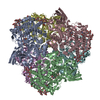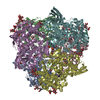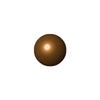[English] 日本語
 Yorodumi
Yorodumi- EMDB-16521: Cryo-EM structure of the Cibeles-Demetra 3:3 heterocomplex from G... -
+ Open data
Open data
- Basic information
Basic information
| Entry |  | ||||||||||||||||||||||||
|---|---|---|---|---|---|---|---|---|---|---|---|---|---|---|---|---|---|---|---|---|---|---|---|---|---|
| Title | Cryo-EM structure of the Cibeles-Demetra 3:3 heterocomplex from Galleria mellonella saliva | ||||||||||||||||||||||||
 Map data Map data | |||||||||||||||||||||||||
 Sample Sample |
| ||||||||||||||||||||||||
 Keywords Keywords | Galleria mellonella / Wax worm saliva / Plastic degradation / Polyethylene degradation / PEases / Hexamerin / Hemocyanin/phenoloxidase superfamily / Metal binding / Arylphorin / UNKNOWN FUNCTION | ||||||||||||||||||||||||
| Function / homology |  Function and homology information Function and homology information | ||||||||||||||||||||||||
| Biological species |  Galleria mellonella (greater wax moth) Galleria mellonella (greater wax moth) | ||||||||||||||||||||||||
| Method | single particle reconstruction / cryo EM / Resolution: 2.29 Å | ||||||||||||||||||||||||
 Authors Authors | Spinola-Amilibia M / Arias-Palomo E / Araujo-Bazan L / Berger JM | ||||||||||||||||||||||||
| Funding support |  Germany, Germany,  Belgium, Belgium,  Spain, 7 items Spain, 7 items
| ||||||||||||||||||||||||
 Citation Citation |  Journal: Sci Adv / Year: 2023 Journal: Sci Adv / Year: 2023Title: Plastic degradation by insect hexamerins: Near-atomic resolution structures of the polyethylene-degrading proteins from the wax worm saliva. Authors: Mercedes Spínola-Amilibia / Ramiro Illanes-Vicioso / Elena Ruiz-López / Pere Colomer-Vidal / Francisco Rodriguez-Ventura / Rosa Peces Pérez / Clemente F Arias / Tomas Torroba / Maria ...Authors: Mercedes Spínola-Amilibia / Ramiro Illanes-Vicioso / Elena Ruiz-López / Pere Colomer-Vidal / Francisco Rodriguez-Ventura / Rosa Peces Pérez / Clemente F Arias / Tomas Torroba / Maria Solà / Ernesto Arias-Palomo / Federica Bertocchini /  Abstract: Plastic waste management is a pressing ecological, social, and economic challenge. The saliva of the lepidopteran larvae is capable of oxidizing and depolymerizing polyethylene in hours at room ...Plastic waste management is a pressing ecological, social, and economic challenge. The saliva of the lepidopteran larvae is capable of oxidizing and depolymerizing polyethylene in hours at room temperature. Here, we analyze by cryo-electron microscopy (cryo-EM) 's saliva directly from the native source. The three-dimensional reconstructions reveal that the buccal secretion is mainly composed of four hexamerins belonging to the hemocyanin/phenoloxidase family, renamed Demetra, Cibeles, Ceres, and a previously unidentified factor termed Cora. Functional assays show that this factor, as its counterparts Demetra and Ceres, is also able to oxidize and degrade polyethylene. The cryo-EM data and the x-ray analysis from purified fractions show that they self-assemble primarily into three macromolecular complexes with striking structural differences that likely modulate their activity. Overall, these results establish the ground to further explore the hexamerins' functionalities, their role in vivo, and their eventual biotechnological application. | ||||||||||||||||||||||||
| History |
|
- Structure visualization
Structure visualization
| Supplemental images |
|---|
- Downloads & links
Downloads & links
-EMDB archive
| Map data |  emd_16521.map.gz emd_16521.map.gz | 187.2 MB |  EMDB map data format EMDB map data format | |
|---|---|---|---|---|
| Header (meta data) |  emd-16521-v30.xml emd-16521-v30.xml emd-16521.xml emd-16521.xml | 24.8 KB 24.8 KB | Display Display |  EMDB header EMDB header |
| FSC (resolution estimation) |  emd_16521_fsc.xml emd_16521_fsc.xml | 13.2 KB | Display |  FSC data file FSC data file |
| Images |  emd_16521.png emd_16521.png | 208.8 KB | ||
| Masks |  emd_16521_msk_1.map emd_16521_msk_1.map | 199.6 MB |  Mask map Mask map | |
| Filedesc metadata |  emd-16521.cif.gz emd-16521.cif.gz | 7.4 KB | ||
| Others |  emd_16521_additional_1.map.gz emd_16521_additional_1.map.gz emd_16521_half_map_1.map.gz emd_16521_half_map_1.map.gz emd_16521_half_map_2.map.gz emd_16521_half_map_2.map.gz | 157.8 MB 157.9 MB 157.8 MB | ||
| Archive directory |  http://ftp.pdbj.org/pub/emdb/structures/EMD-16521 http://ftp.pdbj.org/pub/emdb/structures/EMD-16521 ftp://ftp.pdbj.org/pub/emdb/structures/EMD-16521 ftp://ftp.pdbj.org/pub/emdb/structures/EMD-16521 | HTTPS FTP |
-Validation report
| Summary document |  emd_16521_validation.pdf.gz emd_16521_validation.pdf.gz | 1.1 MB | Display |  EMDB validaton report EMDB validaton report |
|---|---|---|---|---|
| Full document |  emd_16521_full_validation.pdf.gz emd_16521_full_validation.pdf.gz | 1.1 MB | Display | |
| Data in XML |  emd_16521_validation.xml.gz emd_16521_validation.xml.gz | 20.7 KB | Display | |
| Data in CIF |  emd_16521_validation.cif.gz emd_16521_validation.cif.gz | 27.6 KB | Display | |
| Arichive directory |  https://ftp.pdbj.org/pub/emdb/validation_reports/EMD-16521 https://ftp.pdbj.org/pub/emdb/validation_reports/EMD-16521 ftp://ftp.pdbj.org/pub/emdb/validation_reports/EMD-16521 ftp://ftp.pdbj.org/pub/emdb/validation_reports/EMD-16521 | HTTPS FTP |
-Related structure data
| Related structure data |  8ca9MC  8cadC  8canC  8po9C C: citing same article ( M: atomic model generated by this map |
|---|---|
| Similar structure data | Similarity search - Function & homology  F&H Search F&H Search |
- Links
Links
| EMDB pages |  EMDB (EBI/PDBe) / EMDB (EBI/PDBe) /  EMDataResource EMDataResource |
|---|
- Map
Map
| File |  Download / File: emd_16521.map.gz / Format: CCP4 / Size: 199.6 MB / Type: IMAGE STORED AS FLOATING POINT NUMBER (4 BYTES) Download / File: emd_16521.map.gz / Format: CCP4 / Size: 199.6 MB / Type: IMAGE STORED AS FLOATING POINT NUMBER (4 BYTES) | ||||||||||||||||||||||||||||||||||||
|---|---|---|---|---|---|---|---|---|---|---|---|---|---|---|---|---|---|---|---|---|---|---|---|---|---|---|---|---|---|---|---|---|---|---|---|---|---|
| Projections & slices | Image control
Images are generated by Spider. | ||||||||||||||||||||||||||||||||||||
| Voxel size | X=Y=Z: 0.81595 Å | ||||||||||||||||||||||||||||||||||||
| Density |
| ||||||||||||||||||||||||||||||||||||
| Symmetry | Space group: 1 | ||||||||||||||||||||||||||||||||||||
| Details | EMDB XML:
|
-Supplemental data
-Mask #1
| File |  emd_16521_msk_1.map emd_16521_msk_1.map | ||||||||||||
|---|---|---|---|---|---|---|---|---|---|---|---|---|---|
| Projections & Slices |
| ||||||||||||
| Density Histograms |
-Additional map: #1
| File | emd_16521_additional_1.map | ||||||||||||
|---|---|---|---|---|---|---|---|---|---|---|---|---|---|
| Projections & Slices |
| ||||||||||||
| Density Histograms |
-Half map: #1
| File | emd_16521_half_map_1.map | ||||||||||||
|---|---|---|---|---|---|---|---|---|---|---|---|---|---|
| Projections & Slices |
| ||||||||||||
| Density Histograms |
-Half map: #2
| File | emd_16521_half_map_2.map | ||||||||||||
|---|---|---|---|---|---|---|---|---|---|---|---|---|---|
| Projections & Slices |
| ||||||||||||
| Density Histograms |
- Sample components
Sample components
-Entire : Cibeles-Demetra heterocomplex
| Entire | Name: Cibeles-Demetra heterocomplex |
|---|---|
| Components |
|
-Supramolecule #1: Cibeles-Demetra heterocomplex
| Supramolecule | Name: Cibeles-Demetra heterocomplex / type: complex / ID: 1 / Parent: 0 / Macromolecule list: #1-#2 Details: Complex of two trimeric rings of Cibeles and Demetra |
|---|---|
| Source (natural) | Organism:  Galleria mellonella (greater wax moth) Galleria mellonella (greater wax moth) |
-Macromolecule #1: Arylphorin
| Macromolecule | Name: Arylphorin / type: protein_or_peptide / ID: 1 / Number of copies: 3 / Enantiomer: LEVO |
|---|---|
| Source (natural) | Organism:  Galleria mellonella (greater wax moth) Galleria mellonella (greater wax moth) |
| Molecular weight | Theoretical: 83.778 KDa |
| Sequence | String: MQTVLFLAAL VSLAAAGYPQ YHYDVETRKL DPSLLNIQTK VLSLLENWKQ VNPDDEYYKI GKEYNVEANM ESYTNREVVT EFLSLYKAG FIPKNEVFSI FYENQALEVI ALYRLFYYAK DFETFYKTAA FARVWLNEGQ FVYAFYLAVI HRADTRGIVL P APYEIWPE ...String: MQTVLFLAAL VSLAAAGYPQ YHYDVETRKL DPSLLNIQTK VLSLLENWKQ VNPDDEYYKI GKEYNVEANM ESYTNREVVT EFLSLYKAG FIPKNEVFSI FYENQALEVI ALYRLFYYAK DFETFYKTAA FARVWLNEGQ FVYAFYLAVI HRADTRGIVL P APYEIWPE YFMNSDVLSK IYRIQMQKGL IIPEQGPYYG ILSKDNAYYF YANYSGPLTY EDNENLLSYF IEDIGWNSYY YY FHNRFPF WENGEQLIGP LKERRGEIYY YVYQKILARY YLERLANGLG EIPRFNWLDK YQTSYYPLLS SYQLPFAQRN DDY YLASGD NINDIQFIDT YEKTFLQLLQ KGQFKAYKQE VDLYNSKSIN FVGNYWQSNA DLYEKVPKRN YWRSYEATAR RVLG AAPRS SINYENMNIP TALDFYQTSL RDPAFYQLYA KILDYINEYK EYLEPYSQDV LHYVGVKIND VKVDKLVTYF EYFDW NATN AVYLSEQQLD TVSPSYIVRQ PRLNNKPFTV NIDIKSDVES EVVVKIFLGP KYDGNGLPIS LEDNWINFIE LDWFTH KLT SGQNKIARKS EEFFFFKDDS VSLFKIYELL SNGQVPSYMV DRYIYLPRRL ILPRGTQRGF PLQLFVVVYP YQAPVKE WE SMRQYIVDNK PFGYPFDRPV TLPYYFNQPN MYFKDVYVYQ EGEQYPYYNS YWSQNQVSNH UniProtKB: Arylphorin |
-Macromolecule #2: Demetra
| Macromolecule | Name: Demetra / type: protein_or_peptide / ID: 2 / Number of copies: 3 / Enantiomer: LEVO |
|---|---|
| Source (natural) | Organism:  Galleria mellonella (greater wax moth) Galleria mellonella (greater wax moth) |
| Molecular weight | Theoretical: 83.310484 KDa |
| Sequence | String: MKTVLVLAAL IGLVAAGYPL FNNNVKTKTL DPNLVNIQKK VLLLLENWKQ VDPDDEYYKI GKEYNIEANI ESYTNREVVT EFLSLYKTG FTAKNQIFSI YYENQALEVR ALYRLFYYAK DFETFYKTAA FARVWLNEGQ FIYAFYIAVI HRADTRGIVL P APYEIWPE ...String: MKTVLVLAAL IGLVAAGYPL FNNNVKTKTL DPNLVNIQKK VLLLLENWKQ VDPDDEYYKI GKEYNIEANI ESYTNREVVT EFLSLYKTG FTAKNQIFSI YYENQALEVR ALYRLFYYAK DFETFYKTAA FARVWLNEGQ FIYAFYIAVI HRADTRGIVL P APYEIWPE YFVNSDVLAK INRIQMQKGL ILPETAQYYG VLAKDNAYYF YANYSGPWTY ENNENLLSYF IEDVAWNSYY YY FHSKLQF WEKGENAIGP FKERRGEIYY FIYQQILARY YLERLSNGLG EIPRFNWNDR LQAGYYPLLT THQIPFAQRN GDY YLANDD NIEDIQFVDS YEKTFLQFLQ KGQFKAYKQE VDLYNSKSVN FVGNYWQANV DLYEKVPQRN YLRSYEDAAR RILG AAPRN SYENLNVPTA LDFYQTSLRD PAFYQLYAKI LDFINQYKEY LEPYTQDVLH FVGVKINDVK VDKLVTYFEY FDWNA TNAV YLSEQQLDTG SPSYIVRQPR LNNQPFTVTI DIKSDVESEA VIKIFIGPKY DGNGYPIDLE NNWVNLVEID WFTHKL TSG QNKIERKSEN FFWFKEDSVS VSKIYELLNN GQVPRYMIEK FLLLPRRLLL PRGTEGGVPF QFFVFVYPYQ APYKEWE PM KEFVVDNKPF GYPFDRPVTE SYYFTQPNMY FKDVYIYQEG EEYPYYTSYW SQNQVPKH |
-Macromolecule #7: COPPER (II) ION
| Macromolecule | Name: COPPER (II) ION / type: ligand / ID: 7 / Number of copies: 3 / Formula: CU |
|---|---|
| Molecular weight | Theoretical: 63.546 Da |
| Chemical component information |  ChemComp-CU: |
-Macromolecule #8: water
| Macromolecule | Name: water / type: ligand / ID: 8 / Number of copies: 2107 / Formula: HOH |
|---|---|
| Molecular weight | Theoretical: 18.015 Da |
| Chemical component information |  ChemComp-HOH: |
-Experimental details
-Structure determination
| Method | cryo EM |
|---|---|
 Processing Processing | single particle reconstruction |
| Aggregation state | particle |
- Sample preparation
Sample preparation
| Buffer | pH: 7.5 Component:
| |||||||||||||||
|---|---|---|---|---|---|---|---|---|---|---|---|---|---|---|---|---|
| Grid | Model: Quantifoil R2/1 / Material: COPPER / Mesh: 300 / Support film - Material: CARBON / Support film - topology: CONTINUOUS / Pretreatment - Type: GLOW DISCHARGE / Pretreatment - Time: 2 sec. / Pretreatment - Atmosphere: AIR / Details: 25 mA | |||||||||||||||
| Vitrification | Cryogen name: ETHANE / Chamber humidity: 100 % / Chamber temperature: 298 K / Instrument: FEI VITROBOT MARK IV |
- Electron microscopy
Electron microscopy
| Microscope | FEI TITAN KRIOS |
|---|---|
| Image recording | Film or detector model: GATAN K3 BIOQUANTUM (6k x 4k) / Number real images: 6386 / Average exposure time: 5.5 sec. / Average electron dose: 58.3 e/Å2 Details: Images were collected in super-resolution mode (pixel size of 0.543 angstrom) |
| Electron beam | Acceleration voltage: 300 kV / Electron source:  FIELD EMISSION GUN FIELD EMISSION GUN |
| Electron optics | Illumination mode: FLOOD BEAM / Imaging mode: BRIGHT FIELD / Cs: 2.7 mm / Nominal defocus max: 2.6 µm / Nominal defocus min: 1.1 µm |
| Sample stage | Specimen holder model: FEI TITAN KRIOS AUTOGRID HOLDER / Cooling holder cryogen: NITROGEN |
| Experimental equipment |  Model: Titan Krios / Image courtesy: FEI Company |
+ Image processing
Image processing
-Atomic model buiding 1
| Refinement | Space: REAL / Protocol: AB INITIO MODEL / Overall B value: 45.533 |
|---|---|
| Output model |  PDB-8ca9: |
 Movie
Movie Controller
Controller





 Z (Sec.)
Z (Sec.) Y (Row.)
Y (Row.) X (Col.)
X (Col.)






















































